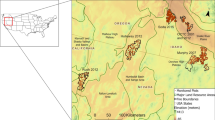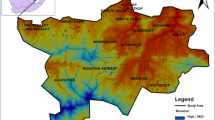Abstract
Context
Forest type (FT) classification provides useful information to ecologists and forest managers by representing similar sites based on species dominance. Various methods have been developed using stand-level or plot-level information, however, these classifications are not always effective at representing broader landscape patterns of species diversity.
Objectives
We classified landscape-level FTs from species habitat models and compared against classifications intended for stand-level information. We used a departure score to assess potential changes to current FT from projected changes in climate and habitat suitability (HS).
Methods
We applied a text mining algorithm, latent Dirichlet allocation (LDA), to 125 species HS models within the eastern United States to define 11 FTs under current conditions. We compared the LDA model against two summations of relative abundance. We then developed a departure score to characterize potential changes to current FTs under projected climate change.
Results
The LDA model showed broad spatial agreement with summations of species relative abundance. However, LDA’s landscape-level dominance of species differed from stand-level classifications of species summations. Varying degrees of pressure from climate change and HS indicated that future FTs could face conditions that result in departures. However, the overall departure scores tended to be lower due to reduced pressure from modeled changes in HS for much of the eastern US.
Conclusions
LDA results are promising for classifying landscape-level FTs. Portraying potential changes in future FTs with departure scores may facilitate better management by aligning the spatial scales of information and not attributing changes to specific species or conditions.






Similar content being viewed by others
Availability of data and material
DISTRIB-II model output used to classify forest types is available from https://www.fs.fed.us/nrs/atlas, forest type and departure maps will also be included. All other material will be made available upon request.
References
Arner SL, Woudenberg S, Waters S et al (2003) National algorithms for determining stocking class, stand size class, and forest type for forest inventory and analysis plots. U.S. Department of Agriculture, Forest Service, Northeastern Research Station, Newtown Square, p 65
Arun R, Suresh V, Veni Madhavan CE, Narasimha Murthy MN (2010) On Finding the natural number of topics with latent Dirichlet allocation: some observations. In: Zaki MJ, Yu JX, Ravindran B, Pudi V (eds) Advances in knowledge discovery and data mining. PAKDD 2010. Springer, Berlin Heidelberg, pp 391–402
Blei DM, Ng AY, Jordan MI (2003) Latent dirichlet allocation. J Mach Learn Res 3(4–5):993–1022
Cao J, Xia T, Li J, Zhang Y, Tang S (2009) A density-based method for adaptive LDA model selection. Neurocomputing 72(7–9):1775–1781
Clements FE (1916) Plant succession: an analysis of the development of vegetation. Carnegie Institution of Washington, Washington
Costanza JK, Coulston JW, Wear DN (2017) An empirical, hierarchical typology of tree species assemblages for assessing forest dynamics under global change scenarios. PLoS ONE 12(9):e0184062
Costanza JK, Faber-Langendoen D, Coulston JW, Wear DN (2018) Classifying forest inventory data into species-based forest community types at broad extents: exploring tradeoffs among supervised and unsupervised approaches. For Ecosyst 5(1):8
Eyre FH (ed) (1980) Forest Cover Types of the United States and Canada. Society of American Foresters, Washington, D.C.
Fauth JE, Bernardo J, Camara M, Resetarits WJ, Van Buskirk J, McCollum SA (1996) Simplifying the Jargon of Community Ecology: a conceptual approach. Am Nat 147(2):282–286
Feilhauer H, Faude U, Schmidtlein S (2011) Combining Isomap ordination and imaging spectroscopy to map continuous floristic gradients in a heterogeneous landscape. Remote Sens Environ 115(10):2513–2524
Gleason HA (1926) The individualistic concept of the plant association. Bull Torrey Bot Club 53(1):7–26
Griffiths TL, Steyvers M (2004) Finding scientific topics. Proc Natl Acad Sci USA 101(suppl 1):5228
Hagen-Zanker A (2009) An improved Fuzzy Kappa statistic that accounts for spatial autocorrelation. Int J Geogr Inf Sci 23(1):61–73
Iverson LR, Scott CT, Dale ME, Prasad A (1996) Development of an Integrated Moisture Index for Predicting Species Composition. In: Kohl M and Gertner GZ (eds) Caring for the forest: research in a changing world, statistics, mathematics and computers, proceedings of the meeting of IUFRO S4.11-00, Tampere, Finland 1995. Swiss Federal Institute for Forest, Snow and Landscape Research, Birmensdorf, Switzerland, pp 101–116
Iverson LR, Prasad AM (2001) Potential changes in tree species richness and forest community types following climate change. Ecosystems 4(3):186–199
Iverson LR, Prasad AM, Matthews SN, Peters M (2008) Estimating potential habitat for 134 eastern US tree species under six climate scenarios. For Ecol Manag 254(3):390–406
Iverson LR, Hutchinson T, Peters M, Yaussy D (2017) Long-term response of oak-hickory regeneration to partial harvest and repeated fires: Influence of light and moisture. Ecosphere 8(1):e01642
Iverson LR, Bartig JL, Nowacki GJ et al (2019a) USDA Forest Service section, subsection, and landtype descriptions for southeastern Ohio. U.S. Department of Agriculture, Forest Service, Northern Research Station. Newtown Square, PA
Iverson LR, Peters MP, Prasad AM, Matthews SN (2019b) Analysis of Climate Change Impacts on Tree Species of the Eastern US: Results of DISTRIB-II Modeling. Forests 10(4):302
Jagarlamudi J, Daumé H, Udupa R (2012) Incorporating lexical priors into topic models. In: Proceedings of the 13th Conference of the European Chapter of the Association for Computational Linguistics. Avignon, France, Association for Computational Linguistics, pp 204–213
Joshi PK, Rawat A, Narula S, Sinha V (2012) Assessing impact of climate change on forest cover type shifts in Western Himalayan Eco-region. J Forestry Res 23(1):75–80
Konrad M (2020) tmtoolkit: Text mining and topic modeling toolkit. Version 0.10.0
Knott JA, Jenkins MA, Oswalt CM, Fei S (2020) Community-level responses to climate change in forests of the eastern United States. Glob Ecol Biogeogr 29(8):1299–1314
Liaw A, Wiener M (2002) Classification and regression by randomForest. R news 2(3):18–22
Mimno DM, Wallach HM, Talley E, Leenders M, McCallum A (2011) Optimizing semantic coherence in topic models. In: Proceedings of the 2011 Conference on Empirical Methods in Natural Language Processing. Association for Computational Linguistics, Edinburgh United Kingdom, pp 262–272
Moss R, Babiker W, Brinkman S et al (2008) Towards new scenarios for the analysis of emissions, climate change, impacts, and response strategies. technical summary. Intergovernmental Panel on Climate Change, Geneva, p 25
Nagel LM, Palik BJ, Battaglia MA et al (2017) Adaptive silviculture for climate change: a national experiment in manager-scientist partnerships to apply an adaptation framework. J For 115(3):167–178
Nevins MT, D’Amato AW, Foster JR (2021) Future forest composition under a changing climate and adaptive forest management in southeastern Vermont, USA. For Ecol Manag 479:118527
Nowacki GJ, Abrams MD (2008) The demise of fire and “Mesophication” of forests in the Eastern United States. Bioscience 58(2):123–138
Nowacki GJ, Abrams MD (2015) Is climate an important driver of post-European vegetation change in the Eastern United States? Glob Chang Biol 21(1):314–334
Pederson N, D’Amato A, Dyer J et al (2015) Climate remains an important driver of post-European vegetation change in the eastern United States. Glob Chang Biol 21(6):2105–2110
Pontius RG Jr, Santacruz A (2019) diffeR: Metrics of Difference for Comparing Pairs of Maps or Pairs of Variables R package version 0.0–6
Peters MP, Iverson LR, Prasad AM, Matthews SN (2019) Utilizing the density of inventory samples to define a hybrid lattice for species distribution models: DISTRIB-II for 135 eastern U.S. trees. Ecol Evol 9(15):8876–8899
Philbin J, Sivic J, Zisserman A (2011) Geometric latent dirichlet allocation on a matching graph for large-scale image datasets. Int J Comput Vis 95(2):138–153
Prasad AM, Iverson LR, Matthews SN, Peters MP (2016) A multistage decision support framework to guide tree species management under climate change via habitat suitability and colonization models, and a knowledge-based scoring system. Landsc Ecol 31(9):2187–2204. https://doi.org/10.1007/s10980-016-0369-7
Pritchard JK, Stephens M, Donnelly P (2000) Inference of population structure using multilocus genotype data. Genetics 155(2):945–959. https://doi.org/10.1093/genetics/155.2.945
Python Software Foundation Python Language Reference. version 2.7.16 edn. Python Software Foundation
R Core Team (2018) R: a language and environment for statistical computing. R Foundation for Statistical Computing, Vienna
Ruefenacht B, Finco MV, Nelson MD et al (2008) Conterminous US and Alaska forest type mapping using forest inventory and analysis data. Photogramm Eng Remote Sens 74(11):1379–1388
Singh V (2017) Topic Modeling with Guided latent Dirichllocation, GuidedLDA: Guided Topic modeling with latent Dirichlet allocation. Version 2.0.0
Tchebakova NM, Parfenova EI, Korets MA, Conard SG (2016) Potential change in forest types and stand heights in central Siberia in a warming climate. Environ Res Lett 11(3):035016
Triepke FJ, Muldavin EH, Wahlberg MM (2019) Using climate projections to assess ecosystem vulnerability at scales relevant to managers. Ecosphere 10(9):e02854
Turner MG, Gardner RH, O’Neill RV (2003) Landscape ecology in theory and practice pattern and process. Springer, New York
Valle D, Baiser B, Woodall CW, Chazdon R (2014) Decomposing biodiversity data using the Latent Dirichlet Allocation model, a probabilistic multivariate statistical method. Ecol Lett 17(12):1591–1601
Webb T, Bartlein PJ (1992) Global changes during the last 3 million years—climatic controls and biotic responses. Annu Rev Ecol Syst 23:141–173
Wu J, Hobbs RJ (2007) Key topics in landscape ecology. Cambridge University Press, Cambridge
Wu J, Qi Y (2000) Dealing with Scale in Landscape Analysis: An Overview. Geographic Inform Sci 6(1):1–5. https://doi.org/10.1080/10824000009480528
Wang X, Grimson E (2007) Spatial Latent Dirichlet Allocation. In: Platt J, Koller D, Singer Y, Roweis S (eds) 20th International Conference on Neural Information Processing Systems, Vancouver, B.C., Canada 2007. vol 20, pp 1577–1584
Ye F, Shi Z, Shi Z (2009) A comparative study of PCA, LDA and Kernel LDA for image classification. In: 2009 International Symposium on Ubiquitous Virtual Reality, Guangju, Korea (South) 2009. IEEE, pp 51–54. https://doi.org/10.1109/ISUVR.2009.26
Acknowledgements
We are grateful to the field crews that collect the Forest Inventory and Analysis data used in our models, in which this work would not be possible as well as sources of digital environmental datasets. We thank Jonathan Knott, Andy Gougherty, and two anonymous reviewers who provided comments on earlier versions of this manuscript.
Funding
This research was funded by the U.S. Department of Agriculture Forest Service.
Author information
Authors and Affiliations
Contributions
All authors contributed to the conceptualization and design of the analysis. Data preparation and modeling was performed by MPP. All authors reviewed model outputs and results. The manuscript was written by MPP with contributions from all co-authors.
Corresponding author
Ethics declarations
Conflict of interest
The authors have no conflicts of interest or competing interests to declare that are relevant to the content of this article.
Additional information
Publisher’s Note
Springer Nature remains neutral with regard to jurisdictional claims in published maps and institutional affiliations.
Disclaimer
The use of trade, firm, or corporation names in this publication is for the information and convenience of the reader. Such use does not constitute an official endorsement or approval by the U.S. Department of Agriculture or the Forest Service of any product or service to the exclusion of others that may be suitable.
Supplementary Information
Below is the link to the electronic supplementary material.
Rights and permissions
About this article
Cite this article
Peters, M.P., Matthews, S.N., Prasad, A.M. et al. Defining landscape-level forest types: application of latent Dirichlet allocation to species distribution models. Landsc Ecol 37, 1819–1837 (2022). https://doi.org/10.1007/s10980-022-01436-6
Received:
Accepted:
Published:
Issue Date:
DOI: https://doi.org/10.1007/s10980-022-01436-6




